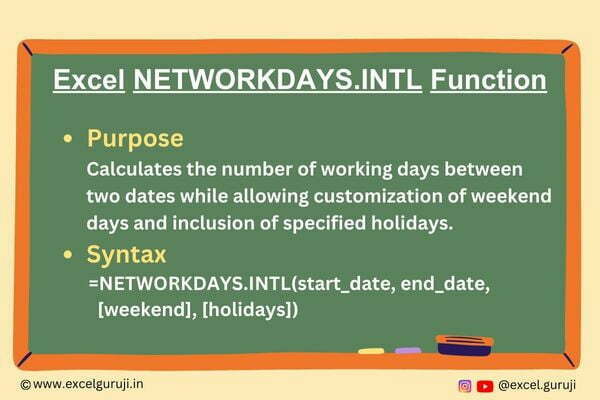Contents
- 1 Excel NETWORKDAYS.INTL Function
- 2 When to Use the Excel NETWORKDAYS.INTL Function in Excel
- 3 What Excel NETWORKDAYS.INTL Function Returns
- 4 Syntax of Excel NETWORKDAYS.INTL Function
- 5 Input Arguments
- 6 Extra Notes
- 7 Examples of the Excel NETWORKDAYS.INTL Function
- 8 Conclusion
- 9 Frequently Asked Questions (FAQs)
Excel NETWORKDAYS.INTL Function

When to Use the Excel NETWORKDAYS.INTL Function in Excel
Excel NETWORKDAYS.INTL function is a powerful tool for calculating the number of working days between two dates while allowing you to customize which days of the week are considered non-working days. It is particularly useful for businesses and organizations that have non-standard workweeks or holidays that fall on different days.
What Excel NETWORKDAYS.INTL Function Returns
The Excel NETWORKDAYS.INTL function returns the count of working days between two specified dates, considering your defined weekend days and any specified holidays.
Syntax of Excel NETWORKDAYS.INTL Function
The syntax of the Excel NETWORKDAYS.INTL function is as follows:
=NETWORKDAYS.INTL(start_date, end_date, [weekend], [holidays])
Input Arguments
Here are the input arguments for the Excel NETWORKDAYS.INTL function:
● start_date: This is the start date of the period for which you want to calculate working days.
● end_date: This is the end date of the period for which you want to calculate working days.
● weekend (optional): This argument allows you to specify which days of the week are considered weekends. A weekend is a numerical or string representation used to define the occurrence of weekends.
You can use a code to represent weekend days. For example, “0000101” considers Friday and Sunday as weekends, while “1111100” considers Monday through Friday as weekends.
You can also use numeric value for this like 2 number will represent Sunday and Monday as weekend, while 3 number will represent Monday and Tuesday as weekend. You don’t need to remember the numeric value, it will be shown to you when you enter the formula

● holidays (optional): You can provide a range of dates that represent holidays. These dates will be excluded from the calculation.
Extra Notes
● If you omit the weekend argument, it defaults to considering only Saturday and Sunday as weekends.
● The start_date and end_date arguments should be valid date values.
● If the start_date is after the end_date, the result will be a negative value, indicating the total count of complete workdays between them.
● When any of the arguments isn’t a valid date, NETWORKDAYS.INTL will result in an #VALUE! error.
● The holidays argument is also optional. If you don’t have any holidays to consider, you can omit it.
Examples of the Excel NETWORKDAYS.INTL Function
Here are a few examples of how to use the NETWORKDAYS.INTL function:
Example 1: Basic Usage
Suppose you want to calculate the number of working days between two dates, considering Saturday and Sunday as weekends. Use the following formula:

=NETWORKDAYS.INTL(A2, B2): In this example, the default NETWORKDAYS.INTL function is used, which considers Saturday and Sunday as weekends by default. So, it calculates the number of working days between September 1, 2023, and September 20, 2023, and correctly returns 14, excluding weekends.
=NETWORKDAYS.INTL(A3, B3, “0000011”): Here, the formula includes the weekend argument “0000011” which specifies that only Saturday and Sunday are considered weekends. This configuration is the same as the default, so it also calculates 14 working days, excluding the weekends.
=NETWORKDAYS.INTL(A4, B4, 1): In this case, the weekend argument is specified as the number 1, which also specifies that only Saturday and Sunday are considered weekends.
Example 2: Custom Weekend Days
Let’s say your organization follows a different workweek, with only Sunday as weekends. So, you can calculate working days using the following formulas:

=NETWORKDAYS.INTL(A2, B2, “0000001”): Here, the formula includes the weekend argument “0000001” which specifies that only Sunday is considered weekends.
=NETWORKDAYS.INTL(A3, B3, 11): In this case, the weekend argument is specified as the number 11, which also specifies that only Sunday is considered weekends.
Example 3: Including Holidays
If you have specific holidays to account for, let’s say, in cells A5:A6, you have a list of holiday dates, and you want to calculate working days between two dates while also considering Monday and Sunday as weekends, you can use the following formula:

Conclusion
In summary, the Excel NETWORKDAYS.INTL function is a versatile tool for calculating working days between two dates while accommodating custom workweeks and holidays. It’s especially valuable for businesses and organizations with unique work schedules.
By mastering the NETWORKDAYS.INTL function, you can streamline your date-related calculations and ensure accurate tracking of working days, helping you plan projects, manage resources, and meet deadlines effectively.
Frequently Asked Questions (FAQs)
Q1: Can the NETWORKDAYS.INTL function handle non-consecutive weekends, such as Thursday and Sunday?
A1: Yes, you can specify any combination of days as weekends using the weekend argument, allowing for flexible customization.
Q2: What happens if the start_date is after the end_date?
A2: If the start_date is later than the end_date, the function will return a negative number.
Q3: Can I use the NETWORKDAYS.INTL function to calculate working hours instead of days?
A3: No, the NETWORKDAYS.INTL function calculates the number of whole working days between two dates, not working hours.
Q4: Is it possible to use cell references for the weekend and holidays arguments?
A4: Yes, you can reference cells that contain the weekend and holidays codes or ranges. This allows for dynamic customization of the function.
Q5: What if I want to calculate working days without excluding any holidays?
A5: If you don’t have holidays to exclude, you can omit the holidays argument, and the function will only consider weekends.
Other Related Excel Functions
Join me on Instagram, YouTube and WhatApp Channel for your daily dose of valuable tips and tricks! Catch insightful videos that will enhance your knowledge and skills. Don’t miss out – follow me now!